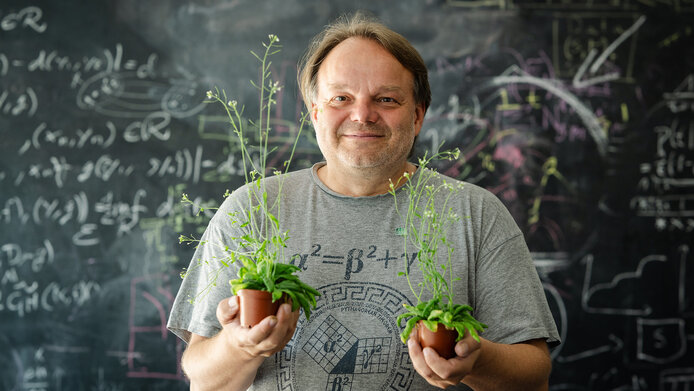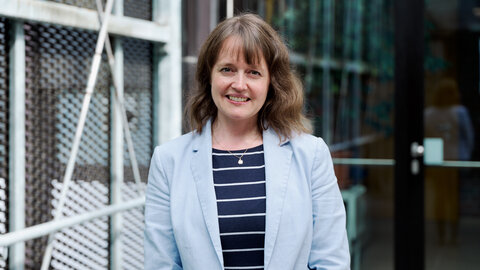How plants control their growth

You study how plants adapt to their environment. Can you briefly outline your field of research?
Jiří Friml: Plants don’t have a nervous system to process information. They also can’t react to their environment like animals or humans and fight or run away. They adapt their growth and development to meet the demands of their environment. Continuous wind, for example, causes the trunk of a tree to grow stronger. In shady places, plants grow towards the light. They have fantastic mechanisms to adapt and survive. For this to work, they have to be able to perceive relevant stimuli in their environment – light, temperature, gravity, or the availability of water and nutrients – and translate them into a developmental change. We have discovered that due to its targeted transport between cells, the plant hormone auxin is the most important and universal signal for this regulatory function. We were also able to uncover important mechanisms in this context, such as how light stimuli affect plants’ growth.
How does this mediating role of auxin work, exactly?
Friml: Auxin is a very simple chemical substance that is transported from cell to cell. There, proteins register the presence of auxin and activate the respective function of the cell. The development of each leaf, flower, and lateral stem begins with a few cells accumulating auxin. The expansion of the root system is controlled in a similar way. Depending on the cell type, the auxin signal can trigger growth, the formation of a new organ, or can even stop growth altogether.
What methods do you use to gain insights into plant development?
Friml: Genetics is a key tool. We modify the genes that encode the proteins in the plant cells. In this way, we can see which protein fulfills which task. We use thale cress (Arabidopsis thaliana), a herbaceous plant that is often found on the edges of fields, as a model organism. Its genome has been fully decoded for decades now. Then there are biochemical methods that show, for example, whether a certain protein binds auxin or transports it further. Developmental biology and, more recently, bioinformatics are also key. Artificial intelligence methods help predict the structures and interactions of proteins. Even if we are still a long way off, we are slowly developing the tools we need to model entire plants on the computer.
Personal details
Jiří Friml is head of the Developmental and Cell Biology of Plants research group at the Institute of Science and Technology Austria (ISTA). The biochemist, cell biologist, and geneticist studied in Brno, Cologne, and Tübingen. He held professorships at the University of Göttingen, the Vlaams Instituut voor Biotechnologie, and Ghent University before joining ISTA in 2012. His numerous scientific awards include two ERC Advanced Grants, which he received in 2017 and 2024, and the 2015 Erwin Schrödinger Award of the Austrian Academy of Sciences. Friml is currently leading the FWF project “Guanylate Cyclase Activity of TIR1/AFBs Auxin Receptors.”
Can your findings be applied in agricultural practice?
Friml: The potential is enormous. In a wheat field, so much of the individual plants’ energy goes into competing for light and nutrients. In nature, this is a necessary survival strategy, but on an agricultural field it’s counterproductive. If we could switch off this mechanism, which is regulated by auxin, the energy could be redirected into the growth of the wheat grains. This would increase the yield of a field by an estimated 25% – an enormous increase. In the same way, plants could be encouraged to develop deeper roots in dry soils to reach water. There are countless examples like this.
What open research questions would you like to answer in the future?
Friml: I’m very interested in the evolutionary development of the auxin system. The molecule appears to have initially been an undesirable metabolic product that had a toxic effect if the dose was too high. How it then became the most important signaling substance of all is a fascinating question. Another focus is on the exact processes within the plant cell. We want to understand exactly what happens in the cell once the auxin has been perceived and how the same signal can have such different effects in different cells.
About the project
The research group led by Jiří Friml focuses on the auxin signaling pathway in plants. Plants’ own compounds regulate their growth and environmental adaptation by reacting to external stimuli such as light or temperature. Friml and his team combine methods from cell and developmental biology, genetics, biochemistry, and bioinformatics to explain auxin transport, cell polarity, and other mechanisms of the signaling pathway.
What will the FWF Wittgenstein Award mean for your research activities?
Friml: If you need money for basic research, you can't be too boring. On the other hand, it’s also important not to be too revolutionary, because then the research could be considered too risky. With the freedom provided by the Wittgenstein Award, we can now try out approaches that may sound a little crazy to our colleagues. One example: A phenomenon we discovered suggests that auxin uses a signaling mechanism that has long been known in animals – and which we humans also use to see or respond to adrenaline. Until now, scientists have been convinced that this mechanism does not exist in plants. However, our results indicate that key elements have been ignored before now. So this is a very controversial topic.
What motivates you in your day-to-day research?
Friml: The question of how plants grow and adapt to their environment has fascinated me since the beginning of my career. As a professor, you have to do a lot of administrative work, which can also be rather uninteresting. It’s also frustrating when a research approach doesn’t work. But every now and then a team member comes to me with a new, surprising, or unexpected result. These are the moments that motivate me. I really enjoy finding out how plants work.





